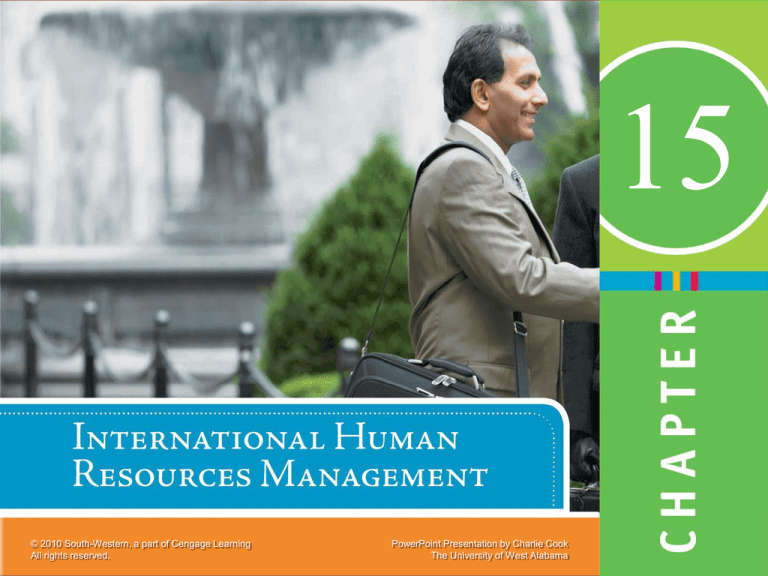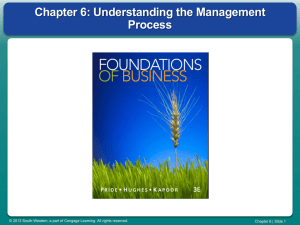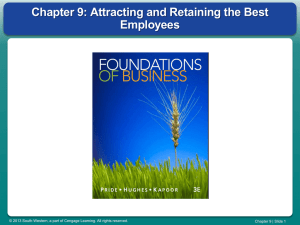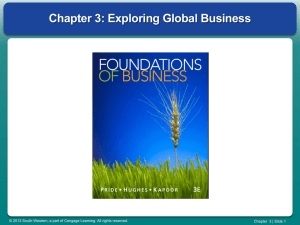
15
© 2010 South-Western, a part of Cengage Learning
All rights reserved.
PowerPoint Presentation by Charlie Cook
The University of West Alabama
Chapter Objectives
After studying this chapter, you should be able to
Identify the types of organizational forms used for
competing internationally.
Explain the economic, political-legal, and cultural
factors in different countries that HR managers
need to consider.
Explain how domestic and international HRM
differ.
Discuss the staffing process for individuals
working internationally.
Identify the unique training needs for international
assignees and their employees
© 2010 South-Western, a part of Cengage Learning. All rights reserved.
15–2
Chapter Objectives (cont’d)
After studying this chapter, you should be able to
Identify the characteristics of a good international
compensation plan.
Reconcile the difficulties of home- and hostcountry performance appraisals.
Explain how labor relations differ around the
world.
© 2010 South-Western, a part of Cengage Learning. All rights reserved.
15–3
Managing Across Borders
• International corporation
Domestic firm that uses its
existing capabilities to
move into overseas
markets.
• Multinational corporation
(MNC)
Firm with independent
business units operating in
multiple countries.
© 2010 South-Western, a part of Cengage Learning. All rights reserved.
• Global corporation
Firm that has integrated
worldwide operations
through a centralized
home office.
• Transnational corporation
Firm that attempts to
balance local responsiveness
and global scale via a
network of specialized
operating units.
15–4
FIGURE
15.1
Types of Organizations
© 2010 South-Western, a part of Cengage Learning. All rights reserved.
15–5
Increasing Importance of Understanding
Global Human Resources Management
International
Mergers and
Acquisitions
Foreign Human
Resources
Global Human
Resources
Management
Global
Competition
Market Access
Opportunities
© 2010 South-Western, a part of Cengage Learning. All rights reserved.
15–6
How International Companies Affect
the World Economy
• Their production and distribution extend
beyond national boundaries, making it easier to
transfer technology.
• They have direct investments in many
countries, affecting the balance of payments.
• They have a political impact that leads to
cooperation among countries and to the
breaking down of barriers of nationalism.
© 2010 South-Western, a part of Cengage Learning. All rights reserved.
15–7
How Does the Global Environment Influence
Management?
• Unified Economies
Closely partnered nations such as the European
Union (EU) have developed into strong competitors.
Promotes job growth in trading nations.
• Cultural Environment
The communication patterns, religion, values and
ideologies, education, and social structure of a host
country influence how HR is conducted in that
country.
© 2010 South-Western, a part of Cengage Learning. All rights reserved.
15–8
FIGURE
15.3
Cultural Environment of International Business
© 2010 South-Western, a part of Cengage Learning. All rights reserved.
15–9
Domestic versus International HRM
• Issues in international HRM in helping
employees adapt to a new and different
environment outside their own country:
Relocation
Orientation
Translation services
© 2010 South-Western, a part of Cengage Learning. All rights reserved.
15–10
International Staffing
• Expatriates, or Home-country Nationals
Employees from the home country who are on
international assignment.
• Host-country Nationals
Employees who are natives of the host country.
• Third-country Nationals
Employees who are natives of a country other than
the home country or the host country.
© 2010 South-Western, a part of Cengage Learning. All rights reserved.
15–11
FIGURE
15.4
Changes in International Staffing over Time
© 2010 South-Western, a part of Cengage Learning. All rights reserved.
15–12
Hiring Host-Country Nationals
• Advantages:
1. Hiring local citizens is generally less costly than
relocating expatriates.
2. Since local governments usually want good jobs
for their citizens, foreign employers may be
required to hire locally.
3. Most customers want to do business with
companies they perceive to be local versus
foreign.
© 2010 South-Western, a part of Cengage Learning. All rights reserved.
15–13
Recruiting Internationally
• Work Permit, or Visa
Government document granting a foreign individual
the right to seek employment.
• Guest Workers
Foreign workers invited to perform needed labor.
• Apprenticeships
Vocational training programs in skilled trades.
• Transnational Teams
Teams composed of members of multiple
nationalities working on projects that span
multiple countries.
© 2010 South-Western, a part of Cengage Learning. All rights reserved.
15–14
1
Global Laws and Pacts Prohibiting Discrimination
U.S. laws affecting firms conducting business outside the United States:
• Title VII of the Civil Rights Act of 1964
• Age Discrimination in Employment Act (ADEA)
• Americans with Disabilities Act (ADA)
International laws that require nondiscrimination in employment:
• European Union (EU)—Equal Pay Directive
• International Labour Organization (ILO)—Equal Remuneration
Convention No. 100
• Organization for Economic Cooperation and Development Enterprises
(OECD)—Guidelines for Multinational Enterprises
• United Nations—Global Compact
© 2010 South-Western, a part of Cengage Learning. All rights reserved.
15–15
Selecting Global Managers
• Global Manager
A manager equipped to run an international
business
• Skills Categories for Global Managers
Ability to seize strategic opportunities
Ability to manage highly decentralized
organizations
Awareness of global issues
Sensitivity to issues of diversity
Competence in interpersonal relations
Community-building skills
© 2010 South-Western, a part of Cengage Learning. All rights reserved.
15–16
FIGURE
15.5
Comparison of Advantages in Sources of Overseas Managers
© 2010 South-Western, a part of Cengage Learning. All rights reserved.
15–17
Selecting Global Managers
1. Begin with self-selection.
2. Create a candidate pool.
3. Assess core skills.
• Skills considered critical
to an employee’s success
abroad.
4. Assess augmented skills
and attributes.
• Skills helpful in facilitating
the efforts of expatriate
managers
© 2010 South-Western, a part of Cengage Learning. All rights reserved.
15–18
2
Skills of Expatriate Managers
CORE SKILLS
AUGMENTED SKILLS
Experience
Technical skills
Decision-making
Negotiation skills
Resourcefulness
Strategic thinking
Strategic thinking
Delegation skills
Adaptability
Change management
Cultural sensitivity
Change management
Team building
Maturity
© 2010 South-Western, a part of Cengage Learning. All rights reserved.
15–19
FIGURE
15.6
Expatriate Selection Criteria
© 2010 South-Western, a part of Cengage Learning. All rights reserved.
15–20
FIGURE
15.7
Causes of Expatriate Assignment Failure
• Family adjustment
• Lifestyle issues
• Work adjustment
• Bad selection
• Poor performance
• Other opportunities arise
• Business reasons
• Repatriation issues
© 2010 South-Western, a part of Cengage Learning. All rights reserved.
15–21
Training and Development
• Essential training program content to prepare
employees for working internationally:
Language training
Cultural training
Assessing and tracking career development
Managing personal and family life
Repatriation
• Culture shock
Perpetual stress experienced by people who settle
overseas.
© 2010 South-Western, a part of Cengage Learning. All rights reserved.
15–22
FIGURE
15.8
Preparing for an International Assignment
To prepare for an international assignment, one should become acquainted
with the following aspects of the host country:
1. Social and business etiquette
2. History and folklore
3. Current affairs, including relations between the host country and the United States
4. Cultural values and priorities
5. Geography, especially its major cities
6. Sources of pride and great achievements of the culture
7. Religion and the role of religion in daily life
8. Political structure and current players
9. Practical matters such as currency, transportation, time zones, and hours of
business
10. The language
© 2010 South-Western, a part of Cengage Learning. All rights reserved.
15–23
3
Nonverbal Communications in Different Cultures
© 2010 South-Western, a part of Cengage Learning. All rights reserved.
15–24
Training Methods
• Reviewing available information about the host
company: books, magazines, video tapes.
• Conversations with host country natives.
• Sensitivity training to become familiar with the
customs and overcome prejudices.
• Temporary assignments to encourage shared
learning.
© 2010 South-Western, a part of Cengage Learning. All rights reserved.
15–25
FIGURE
15.9
A Synthesis of Country Clusters
© 2010 South-Western, a part of Cengage Learning. All rights reserved.
15–26
FIGURE
15.10
Selected Foreign-Born Executives
COMPANY, NAME, AND COUNTRY OF ORIGIN
Chevron, David O'Reilly (Ireland)
Citigroup, Vikram Pandit (India)
Dow Chemical, Andrew Liveris (Australia)
PepsiCo, Indra Nooyi (India)
Coca-Cola, Muhtar Kent (Turkey)
Alcoa, Alain J. P. Belda (Morocco)
Eli Lily, Sydney Taurel (Morocco)
3M, George W. Buckley (Great Britain)
Eastman Kodak, Antonio Perez (Spain)
© 2010 South-Western, a part of Cengage Learning. All rights reserved.
15–27
Assessing and Tracking Career Development
• Developmental and Career Advantages of an
International Assignment:
Increases the expatriate’s responsibilities and
influence within the corporation
Provides a set of unique experiences beneficial to
both the individual and the firm
Enhances understanding of the global marketplace
Offers the opportunity to work on a project
important to the organization
© 2010 South-Western, a part of Cengage Learning. All rights reserved.
15–28
4
Repatriation Checklist
Before they go:
• Make sure there is a clear need for the international assignment.
Don’t send someone abroad unnecessarily. Develop a clear set
of objectives and expectations and time frames in which they
should be met.
• Make sure that your selection procedures are valid. Select the
employee and also look at and involve the employee’s family.
• Provide (or fund) language and cultural training for the employee
and the employee’s family.
• Offer counseling and career assistance for the spouse.
• Establish career planning systems that reward international
assignments and lead to promotion and knowledge sharing.
© 2010 South-Western, a part of Cengage Learning. All rights reserved.
15–29
4
Repatriation Checklist (cont’d)
While they are away:
• Jointly establish a developmental plan that focuses on the goal
to be achieved.
• Tie performance objectives to the achievement of the goal.
• Identify mentors who can be a liaison and support person from
home.
• Keep communications open so that the expatriate is aware of job
openings and opportunities.
• Arrange for frequent visits back home (for the employee and the
family). Make certain they do not lose touch with friends and
relatives.
© 2010 South-Western, a part of Cengage Learning. All rights reserved.
15–30
4
Repatriation Checklist (cont’d)
When they come back home:
• Throw a “welcome home” party and arrange for a meeting with
other former expatriates.
• Offer counseling to ease the transition.
• Arrange conferences and presentations to make certain that
knowledge and skills acquired away from home are identified and
disseminated.
• Set up an expatriate database to help other employees who go
abroad later.
• Get feedback from the employee and the family about how well the
organization handled the repatriation process..
© 2010 South-Western, a part of Cengage Learning. All rights reserved.
15–31
Global Compensation Challenges
• Different countries have different norms for
employee compensation:
Financial (money) incentives versus nonfinancial
incentives (prestige, independence, and influence)
Individual rewards versus collectivist concerns for
internal equity and personal needs
General rule:
Match the rewards to the values of the local culture—create
a pay plan that supports the overall strategic intent of the
organization but provides enough flexibility to customize
particular policies and programs to meet the needs of
employees in specific locations.
© 2010 South-Western, a part of Cengage Learning. All rights reserved.
15–32
FIGURE
15.11
Hourly Wages in Different Countries*
COUNTRY
Norway
Denmark
Germany
Netherlands
Belgium
Sweden
Switzerland
Austria
Finland
Luxembourg
United Kingdom
Australia
Ireland
Canada
Italy
France
United States
$/HOUR
41.05
35.45
34.21
32.34
31.85
31.80
30.67
30.46
29.90
27.74
27.10
26.14
25.96
25.74
25.07
24.90
23.82
COUNTRY
Japan
Spain
Greece
Korea, Republic of
New Zealand
Israel
Singapore
Portugal
Czech Republic
Taiwan
Hungary
Hong Kong SAR (1)
Poland
Brazil
Mexico
Philippines
Sri Lanka
$/HOUR
20.20
18.83
16.10
14.72
14.47
12.98
8.55
7.65
6.77
6.43
6.29
5.78
4.99
4.91
2.75
1.07
0.54
*Hourly compensation costs in U.S. dollars for production workers in manufacturing.
© 2010 South-Western, a part of Cengage Learning. All rights reserved.
15–33
Compensation of Host-Country Employees
• Hourly wages can vary dramatically from
country to country.
• Pay periods are different.
• Seniority may be an important factor.
• High pay rates can upset local compensation
practices.
• Bonuses, profit-sharing, benefits and paid
leave may be more extensive and legally
required.
© 2010 South-Western, a part of Cengage Learning. All rights reserved.
15–34
Compensation of Host-Country Managers
• Global Compensation System
A centralized pay system whereby
host-country employees are
offered a full range of training
programs, benefits, and pay
comparable with a firm’s
domestic employees but adjusted
for local differences
© 2010 South-Western, a part of Cengage Learning. All rights reserved.
15–35
Compensation of Expatriate Managers
• An effective international compensation program must:
1.
2.
3.
4.
5.
Provide an incentive to leave the United States
Allow for maintaining an American standard of living
Provide for security in countries that are politically unstable or
present personal dangers
Include provisions for good health care
Reimburse the foreign taxes the employee is likely to have to pay (in
addition to having to pay domestic taxes) and help him or her with
tax forms and filing
Provide for the education of the employee’s children abroad, if
necessary
7. Allow for maintaining relationships with family, friends, and
business associates via trips home and other communication
technologies
6.
Facilitate the expatriate’s reentry home
9. Be in writing
8.
© 2010 South-Western, a part of Cengage Learning. All rights reserved.
15–36
Expatriate Compensation Systems
• Home-Based Pay
Pay based on an expatriate’s home country’s
compensation practices
• Balance-Sheet Approach
A compensation system designed to match the
purchasing power in a person’s home country
1. Calculate base pay
2. Figure cost-of-living allowance (COLA)
3. Add incentive premiums
4. Add assistance programs
© 2010 South-Western, a part of Cengage Learning. All rights reserved.
15–37
Expatriate Compensation Systems (cont’d)
• Split Pay
A system whereby expatriates are given a portion of
their pay in the local currency to cover their day-today expenses and a portion of their pay in their
home currency to safeguard their earnings from
changes in inflation or foreign exchange rates
• Host-Based Pay
Expatriate pay is comparable to that earned by
employees in a host country to which the expatriate
is assigned.
© 2010 South-Western, a part of Cengage Learning. All rights reserved.
15–38
Expatriate Compensation Systems (cont’d)
• Localization
Adapting pay and other compensation benefits to
match that of a particular country
Reduces resentment among local staff members if
they are earning significantly less.
• Other Issues
Adequacy of medical care
Personal security
Compensation policies of competitors
© 2010 South-Western, a part of Cengage Learning. All rights reserved.
15–39
Performance Appraisal
of International Managers
• Who Should Appraise Performance?
Home-country evaluations
Host-country evaluations
• Adjusting Performance Criteria
Augmenting job duties
Individual learning
Organizational learning
• Providing Feedback
Debriefing interview
© 2010 South-Western, a part of Cengage Learning. All rights reserved.
15–40
The Labor Environment Worldwide
• International Differences in Unions:
The level at which bargaining takes place (national,
industry, or workplace)
The degree of centralization of union-management
relations
The scope of bargaining (parties and issues)
The degree to which government intervenes
The degree of unionization and union strength
The political affiliations of unions
© 2010 South-Western, a part of Cengage Learning. All rights reserved.
15–41
augmented skills
host-based pay
balance sheet approach
host country
codetermination
host-country nationals
core skills
international corporation
cultural environment
localization
culture shock
multinational corporation (MNC)
expatriates, or home-country nationals
repatriation
failure rate
split pay
global compensation system
third-country nationals
global corporation
transnational corporation
global manager
transnational teams
guest workers
work permit, or visa
home-based pay
© 2010 South-Western, a part of Cengage Learning. All rights reserved.
15–42





